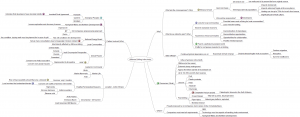The Arctic oftentimes seems desolate, savage and unfamiliar. Many however, look past that. There is economic interest in the Arctic; tens of millions of barrels of oil are located deep underground, mostly offshore in the ocean. Arctic oil has drawn the attention of the government, several corporations, and the world, and therein lies the wicked problem.
This mind map illustrates the factors surrounding offshore Arctic drilling. Corresponding numbers indicate similar or related topics.
To understand why offshore drilling is a wicked problem, there are many factors that must be examined. Offshore drilling is fairly uncharted territory; opponents argue that even experimental drilling would be a dangerous undertaking. Currently, the National Energy Board does not have full confidence that the technology used in oil drilling would be sufficient in the harsh Arctic terrain. Noted on the mind map under “When?” is the fact that there are no definitive plans to drill oil within the next few years (Jones).
There are many stakeholders in the proposed projects: Aboriginal peoples, their local communities, the oil companies and the government (in the form of the Aboriginal Affairs and Northern Development Department), all consulting with the National Energy Board (National Energy Board). These are all listed in the “Who?” section of the mind map. Many of these groups hold mixed opinions and conflicting values on oil drilling in the Arctic. Stakeholders must decide if the “risk inherent in everything we do” (National Energy Board) is worth the reward.
Each stakeholder has a different role in consultation. Some are linked to other aspects of the mind map. For example, the Inuvialuit have settled with the government in the Inuvialuit Final Agreement, which gives corporations absolute liability for any damage that occurs during and after development. This links them to the “What are the consequences? (Why?)” portion of the mind map. There are several links to the “Why?” portion of the map. After all, all stakeholders must consider the reasons behind their support or opposition. The map links them to the consequences, but also to the question “What do we have to gain?”
Also very closely connected to the “Why?” section is the Arctic as a location, which is a separate section on the mind map. The Arctic has numerous biophysical components that must be taken into consideration (Samuels, Amstutz, and Crowley). It is home to “24-hour darkness, high winds and extreme cold” (National Energy Board) This is where the map links once again to local communities and Aboriginal peoples. Communities have expressed interest in jobs with oil companies; they would bring their experience in a largely unexplored environment to the project.
The last area of the mind map explores oil as a resource. Upon research society’s dependency on oil becomes clear. With an estimated one quarter of the world’s oil resources in addition to natural gas liquids (Robertson and Pierce), the Arctic might eventually fuel this petroleum-powered world. However, past incidents related to oil drilling must be considered. The most prominent of the ones listed in the mind map is the Deepwater Horizon blowout. This blowout involved 5 million liters of oil being spilled into the ocean only a five years ago in 2010; the incident is still fresh in the minds of the National Energy Board.
Despite this, local communities and corporations alike acknowledge the global need for energy. Though conflicting values and lack of information make this situation a wicked problem, it is one stakeholders are determined to solve. Unless society commits to phasing out fossil fuels, the wicked oil and gas problem in the Arctic will become increasingly relevant in the future.
References
Jones, Jeffrey. “Imperial Oil Leads Push to Drill Deep in Canadian Arctic.”The Globe and Mail. The Globe and Mail, 29 Sept. 2013. Web. 23 Sept. 2015. <http://www.theglobeandmail.com/report-on-business/industry-news/energy-and-resources/major-oil-companies-apply-to-drill-deep-in-canadian-arctic/article14596797/>
Kaplan, Jed O., and Mark New. “Arctic Climate Change with a 2 ∘C Global Warming: Timing, Climate Patterns and Vegetation Change.” Climatic Change 79.3-4 (2006): 213-41. Web. 23 Sept. 2015. <http://link.springer.com.ezproxy.library.ubc.ca/article/10.1007%2Fs10584-006-9113-7>
Review of Offshore Drilling in the Canadian Arctic: Preparing for the Future. Calgary: National Energy Board, 2011. National Energy Board. Government of Canada, Dec. 2011. Web. 21 Sept. 2015. <https://www.neb-one.gc.ca/nrth/rctcffshrdrllngrvw/2011fnlrprt/index-eng.html>
Robertson, Jessica, and Brenda Pierce. “USGS Newsroom.” USGS Release: 90 Billion Barrels of Oil and 1,670 Trillion Cubic Feet of Natural Gas Assessed in the Arctic. U.S. Geological Survey, 23 July 2008. Web. 22 Sept. 2015. <http://www.usgs.gov/newsroom/article.asp?ID=1980#.VgOEHvlVikp>
Samuels, William B., David E. Amstutz, and Heather A. Crowley. “Arctic Climate Change and Oil Spill Risk Analysis.” Frontiers of Earth Science 5.4 (2011): 350-62. Springer Link. SP Higher Education Press, 16 Dec. 2011. Web. 23 Sept. 2015. <http://link.springer.com.ezproxy.library.ubc.ca/article/10.1007%2Fs11707-011-0198-6#>
